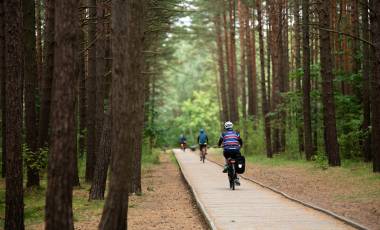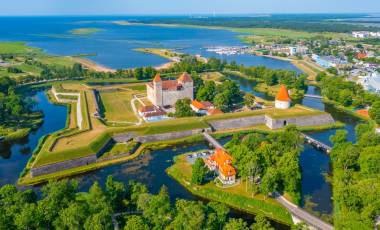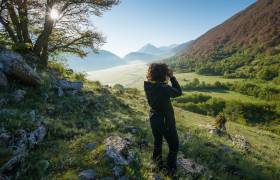We believe that travel should ignite a sense of wonder in the world, and that’s exactly what a trip to Lithuania can do. This lesser-visited southern Baltic state is a fascinating country, rich in history, beauty, and culture. Taking you far beyond the typical tourist path, you’ll soon find that a visit to Lithuania is filled with unique and memorable experiences. So, read on as we share five spectacular sites you can see on our adventures across Lithuania.
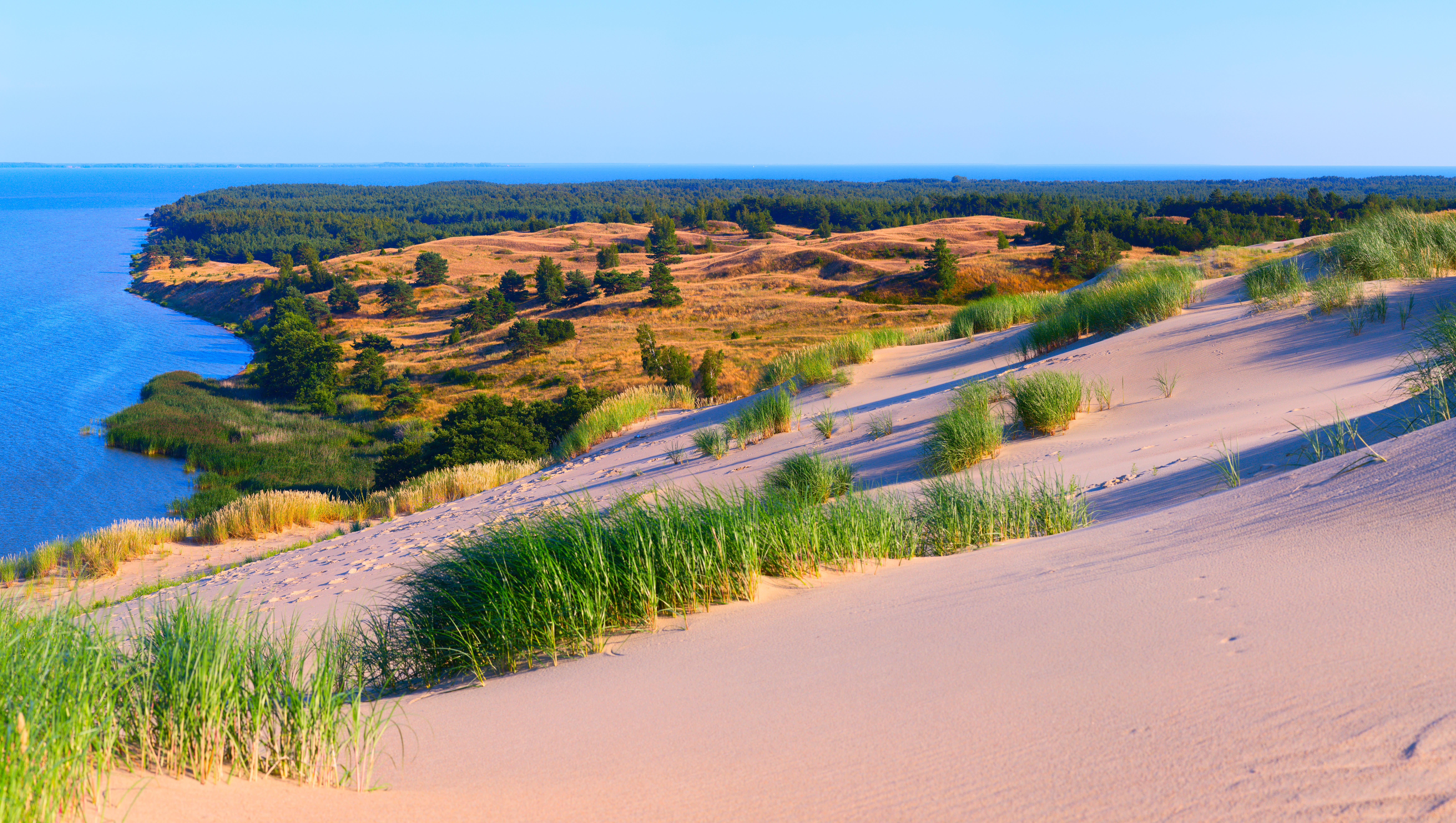
Explore the largest drifting dune in Europe
The remarkable 98 km-long Curonian Spit was formed 5,000 years ago. Created from sand transported by currents, the locals coined it the ‘Lithuanian Sahara’. As an immense dune ridge, it separates the Curonian Lagoon from the Baltic Sea and represents a dramatic yet fragile feat of nature.
As the Curonian Spit evolved over time, it became covered by forest and inhabited by humans. Yet, it continues to fight a battle of erosion against the wind and waves. Today, this UNESCO World Heritage site not only offers stunning panoramic viewpoints but also a fascinating cultural heritage where communities have adapted to survive in this unique environment.
On day 8 of both our Cycle the Baltics and Discover the Baltics trips, there’s the opportunity to explore the Great Dune Ridge. You also get to take in Witches’ Hill, an area renowned for its unique wooden sculptures crafted by local folk artists since 1979. These artworks depict characters from regional folklore, including the tale of Naglis, the evil dragon, and his love quest for Neringa, the beautiful, friendly giant.
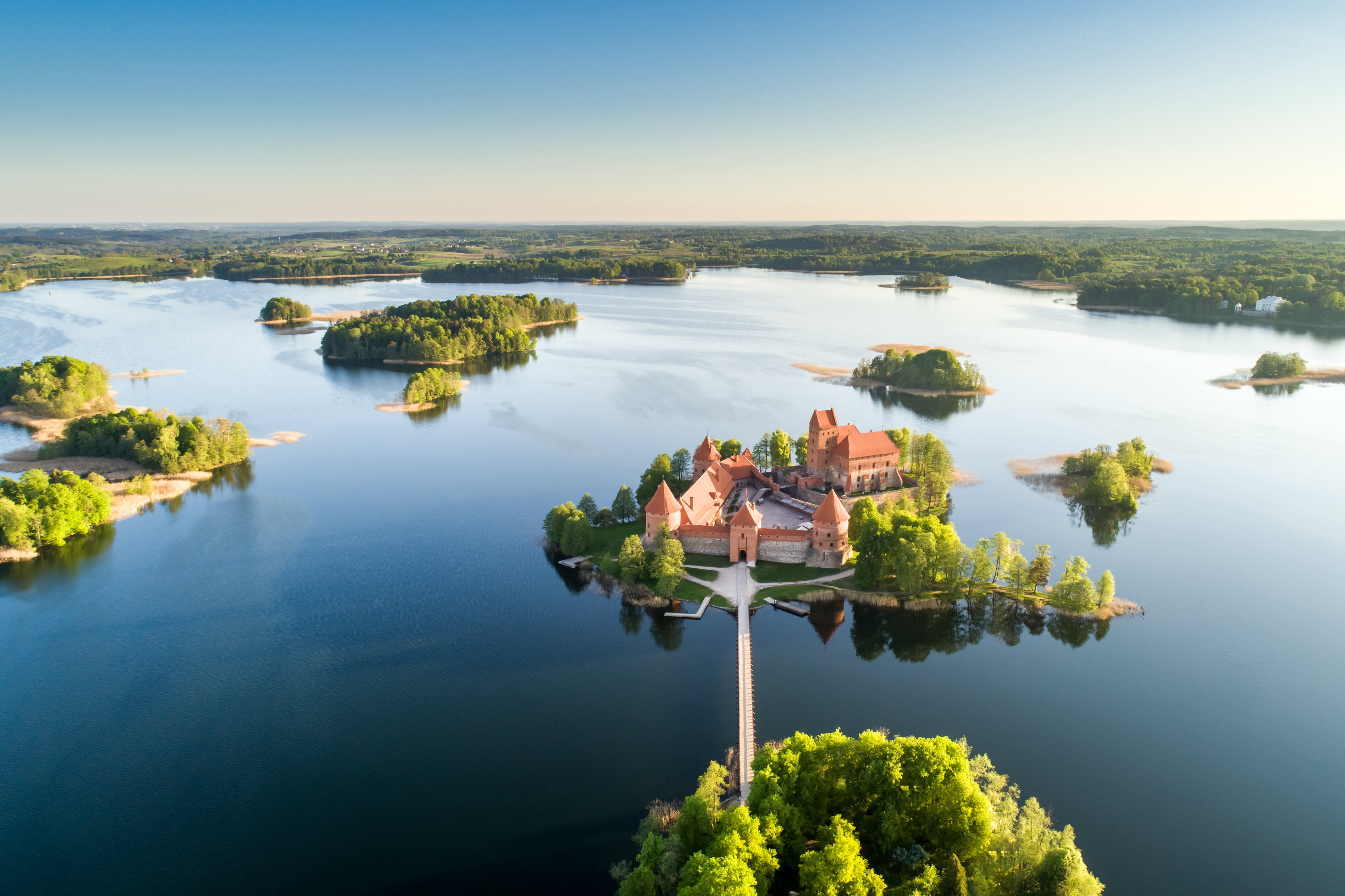
Marvel at the magic of Trakai Castle
Trakai Castle is reminiscent of a fairytale. You’ll find it perched on an island in Lake Galvė, one of the deepest lakes in Lithuania. As you cross the long wooden bridge to the castle, you get an up-close view of its striking Gothic-style architecture. This enchanting exterior provides the setting for a glimpse into Trakai’s storied past.
The Grand Duke Kęstutis of Lithuania began constructing the castle in the 14th century, making it his primary residence. It was later finished by his son, Vytautas. At the time, it was the only castle built on water in Eastern Europe and considered a medieval defence masterpiece.
It’s easy to spend at least half a day at Trakai Castle, immersing yourself in its romantic surroundings and intriguing history. You can enjoy a stunning walk around the lake, which, in winter, turns into a magical ice-skating rink. It’s also worth going inside the castle, where you can learn more about the unique history of Trakai. In the castle museum, you can browse the fascinating artefacts. Meanwhile, its halls host a variety of art collections and display items. In total, there are almost 400,000 exhibits!
Trakai Castle is approximately 30 km from Lithuania’s capital, Vilnius. On day 3 of our Walks of the Baltics and Finland trip, there’s the opportunity to visit here before we begin our trail in Zemaitijos National Park. Trakai Castle is also the penultimate destination on our Discover the Baltic trip, providing a compelling conclusion to this tour. At time of writing, Trakai Castle is currently undergoing renovations, but it is still possible to visit the castle’s extensive museum inside.
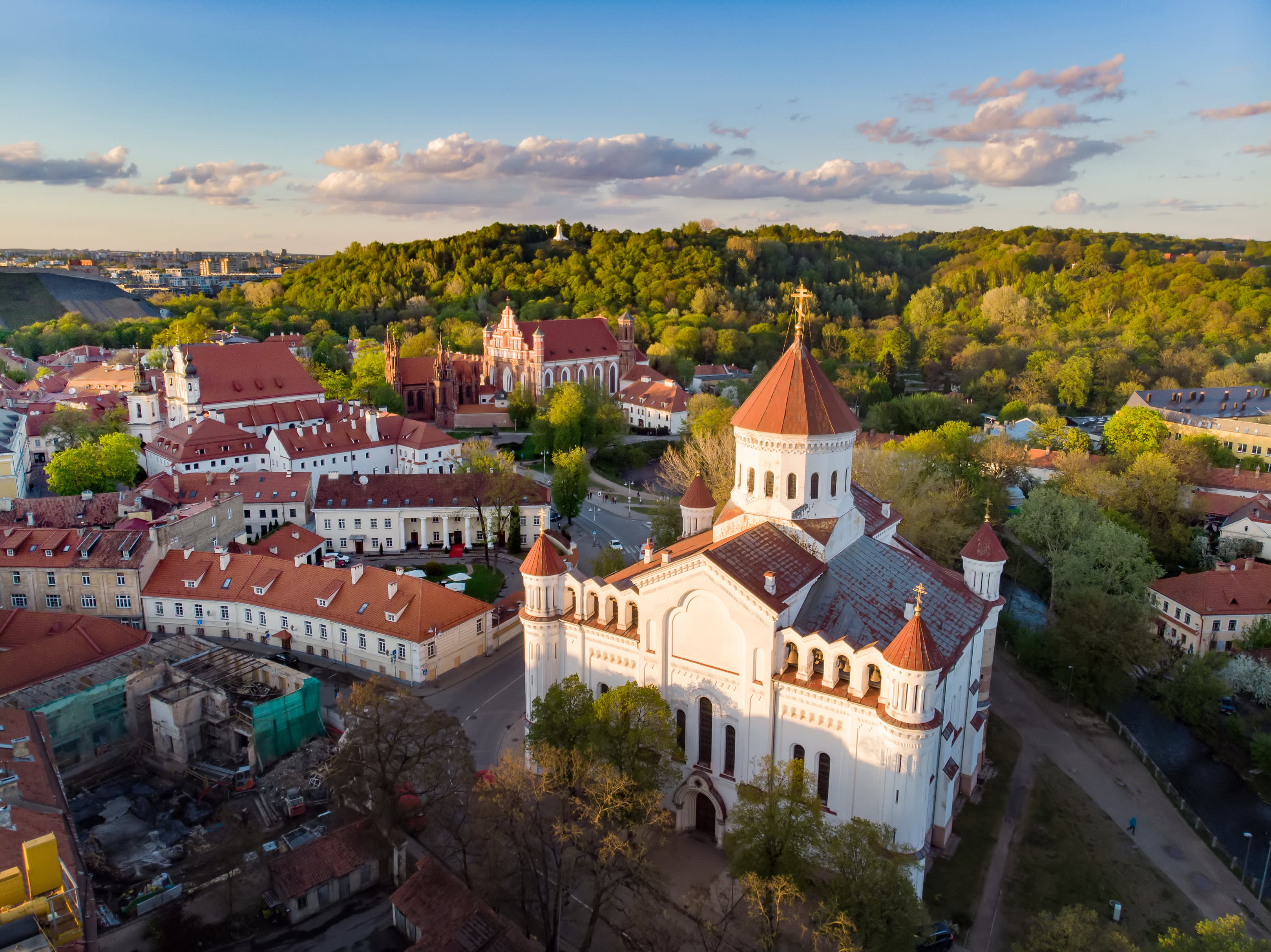
Discover the charm of Vilnius Old Town
Visiting Vilnius Old Town is a captivating experience, where every corner holds a piece of history, and every flavour tells a story. As one of Northern Europe’s largest surviving medieval old towns, it offers a stunning blend of historical and cultural interests alongside its picturesque charm.
The Old Town is a UNESCO World Heritage Site with plenty of must-see attractions, many of which you can experience on day 2 of our Walks of the Baltics and Finland trip. Wandering through its narrow, cobblestone streets, you’ll be greeted by the city’s magnificent architecture. Amidst the Gothic, Renaissance, Baroque, and Classical buildings, every corner tells a story of Vilnius’ diverse influences throughout time. Discover the iconic Vilnius Cathedral with its impressive neoclassical façade and the historic Gediminas’ Tower, which offers panoramic city views. And don’t miss the revered Gates of Dawn, an important pilgrimage site with a highly revered Renaissance painting of the Virgin Mary.
Vilnius is spectacular any time of year. However, if you book your trip on the lead-up to the festive season, with our Winter in the Baltics, Helsinki & Stockholm trip, you will get the chance to see the Cathedral Square transform into a magical Christmas Market from 1st December to 1st January of the following year. Here, the festive stalls offer handmade crafts, holiday treats and intricate decorations.
At other times of the year, there are still plenty of opportunities to sample some traditional Lithuanian fare. Local delicacies like the hearty Cepelinai (potato dumplings) and the savoury Šaltibarščiai (bright pink cold beet soup) offer a real taste of the country’s culinary heritage.
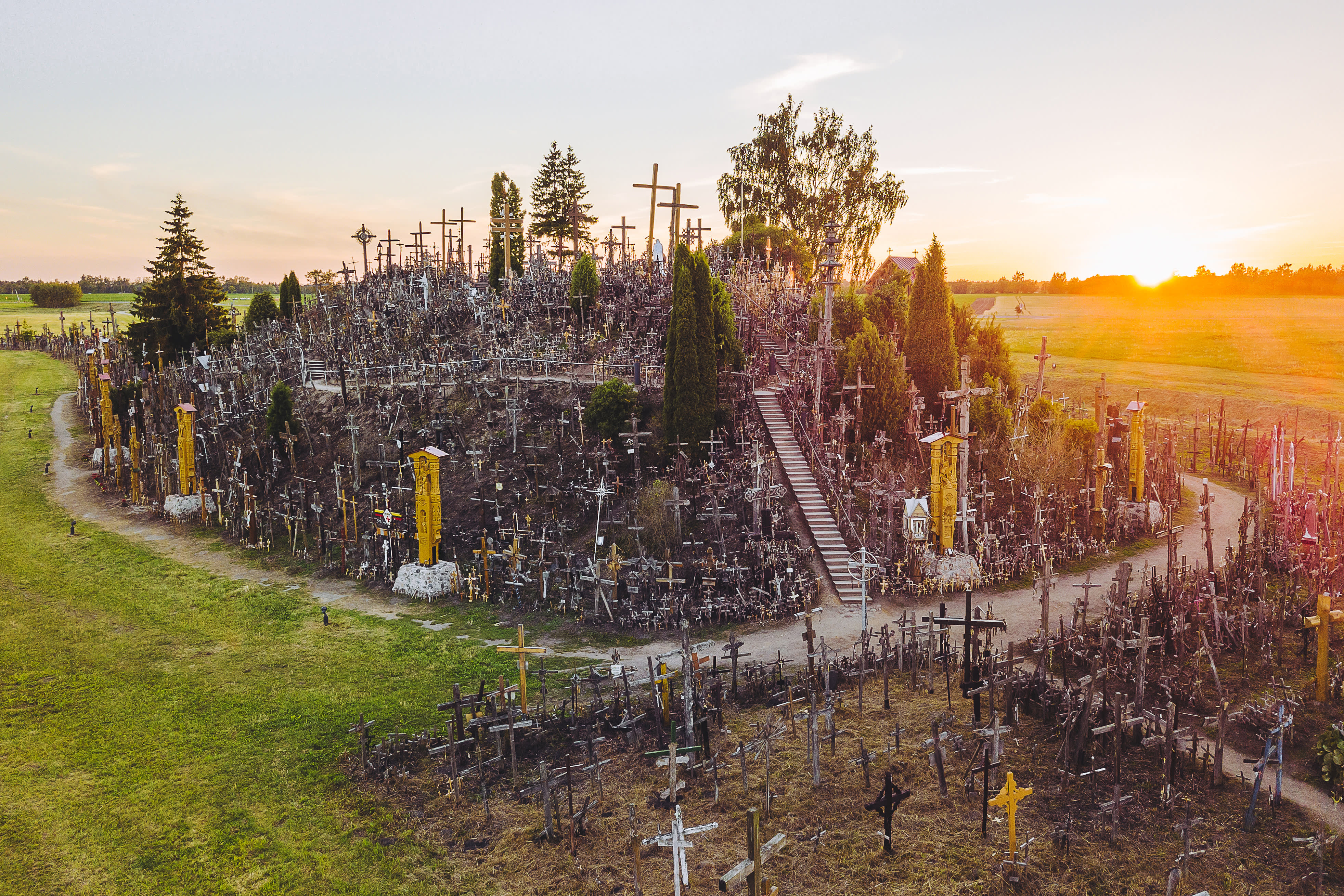
Visit the sacred Hill of Crosses
The Hill of Crosses in Lithuania stands as a mesmerising and symbolic site, drawing visitors from around the globe. Located just outside the city of Šiauliai, this unique pilgrimage site features over 100,000 crosses. They range from simple wooden crosses to elaborate metal works. But how they appeared is surrounded by legend.
You can visit the Hill of Crosses on our Discover the Baltics trip, where you’ll gain a profound glimpse into this piece of Lithuania’s spiritual and historical heritage. The site is a symbol of national and religious identity, with cross-making a significant part of Lithuanian heritage. It also epitomises the qualities of resilience and devotion. It has been destroyed more than four times, including in 1961, when it was completely bulldozed and burned down. Yet, The Hill of Crosses has been rebuilt and is now maintained by various organisations.
The visual impact of thousands of crosses clustered together against the landscape is striking and unforgettable. The atmosphere is serene, with the gentle jangle of rosaries hanging from the crosses, making it not only a place for religious contemplation but also evoking hope for the future. Encountering this powerful symbol of faith and perseverance can be a moving experience, making the Hill of Crosses a must-visit for anyone travelling to Lithuania.

Unearth ancient secrets at Kernavė
The Kernavė Archaeological Site in Lithuania offers a vivid exploration into the country’s ancient past. Nestled in the picturesque Neris River Valley, this site is famed for its archaeological treasures. From impressive hill forts to burial sites and other monuments, the evidence of human settlements spans over 10,000 years. Recognised as a UNESCO World Heritage Site in 2004, Kernavė is not only a window into Lithuania’s ancient history but also an incredible insight into its cultural heritage.
Each year in early July, Kernavė Archaeological Site comes alive during the annual Kernavė Archaeological Festival. With experts in reconstructed archaeology and re-enactors, this event showcases traditional crafts, medieval combat, and archaeological practices. It’s a vibrant celebration of Lithuania’s heritage, offering hands-on experiences that bring ancient traditions and history to life.
Visit Kernavė Archaeological Site on our Walks of the Baltics and Finland to explore these extensive archaeological findings that reveal the area’s prominence as a centre of commerce, religion, and politics through the ages. The site’s cultural significance, combined with its educational programmes and scenic beauty, makes it a captivating destination if you are a history lover and are interested in the legends and folklore of Lithuania’s past.
If these sights have inspired you to book your next adventure in Lithuania, head over to our Lithuania Holidays page to learn more about the trips we offer which combine Lithuania and other fascinating countries in the Baltics.

